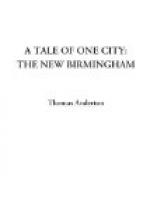The Gothic revival has spread to domestic architecture, and the old, dreadfully-symmetrical brick and stuccoed house, and the hybrid Italian villa, make way for residential structures with gabled roofs, pointed arch windows, red tiles instead of dull-coloured slates, and attractive detail and ornamentation. In looking at such houses, one can hardly fail to be struck by the difference that may be effected by using the simplest materials—but using them with discrimination and taste. One architect may plan a house which will be plain to ugliness, the bricks laid in the most severe and commonplace fashion, and the outlines of the design—if design it can be called—devoid of any grace or variety. No projections to break up the dull flatness and give light and shade; no attempt to relieve the unmitigated square, hut-like appearance of the building. Another puts a pointed roof to his house, pierces it with pretty windows that have form without diminishing the light. He runs some courses of brick work round his building laid in diagonal or otherwise diversified lines. He places a porch at the entrance which has a touch of picturesqueness, and the result is a house that is pleasing to look upon, has at all events a suggestion of form and appearance, and all without any corresponding expense, because he has used his material with skill and taste.
In Birmingham we have seen how much may be done in this direction in various ways, especially in the matter of the Board Schools. When the building of these schools was commenced the firm of Martin and Chamberlain were selected as architects. They had to design comparatively cheap buildings, for anything like extravagance in the way of ornamentation would probably have provoked much hostility. Brick and wood had to be the chief materials employed, but by using these with device and taste good schools were produced from an art point of view, and which, in their way, are a little education to those who attend them.
Possibly there are still not a few among us who think that because there is an element of design and attractiveness in the appearance of these schools money has been needlessly expended. Such persons insist upon it that only ugliness can be really economical, and that the simplest ornamentation or beauty of form must mean superfluous cost. The number of those who take this narrow view is happily limited, and is becoming less owing to the improved and growing taste for art that has been unmistakeably manifest of late years.
I have been led into this trifling digression by speaking of the houses now built in that suburb of Birmingham inhabited by the wealthier classes. These residents are, as I have said, better educated than their fathers, and they have different notions as to how they should live and what sort of houses they should live in. They are not merely people who are beginning to prosper and have only just emerged from the chrysalis state of modern civilization, but are citizens who have been




